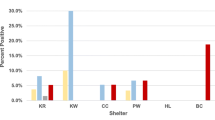Abstract
From the point of view of the human disease, dogs are the most important animal reservoir of Lyme borreliosis; therefore, they are used as ‘sentinel animals’. In order to know the epidemiological characteristics of dogs with antibodies against Borrelia burgdorferi, 146 canine sera samples collected during 1993–94 have been studied. The antibody detection was made by an indirect immunofluorescence method and confirmed by a haemagglutination test. Seventeen dogs (11.6%) were seropositive, of which seven were hunting dogs, three were shepherd dogs, five were domestic pets, one was a watchdog and one was a stray dog. Seven dogs had longhair phenotype, 2 medium length type, 4 hard-hair and the other 4 were short-haired. Twelve seropositive dogs were males and five were females. All seropositive dogs were more than 1 year old. The dogs with greater seroprevalence were those that harboured ticks more often than the rest. Spring and summer were the seasons when more ticks were observed. The seroprevalence found in dogs was similar to that previously obtained in humans in this area. This finding gave evidence to an intimate association between human and canine seroprevalence.
Similar content being viewed by others
References
Uría DF, Calatayud M, Mongelos JM, Miguel MD, Cobos A, Suarez T. Meningopolioneuritis como manifestación de la enfermedad de Lyme. Med Clin 1987; 89: 381–383.
Saz JV, Merino FJ, Beltran M. Situación actual de la enfermedad de Lyme en España: aspectos clínicos y epidemiológicos. Rev Clín Esp 1995; 195(1): 44–49.
Saz JV, Nuncio S, Merino FJ, Aquise M, Medina J, Filipe AR. Enfermedad de Lyme en la provincia de Soria: Estudio clinicoepidemiologico. Enf Infec y Microbiol Clín 1994; 12(2): 52–59.
Rand PW, Lacombe EH, Smith RP, Gensheimer K, Dennis DT. Low seroprevalence of human lyme disease near a focus of high entomologic risk. Am J Trop Med Hyg 1996; 55(2): 160–164.
Falco RC, Smith HA, Fish D, et al. The distribution of canine exposure to Borrelia burgdorferi in a Lyme Disease endemic area. Am J Public Health 1993; 83(9): 1305–1310.
Lindenmayer JM, Marshall D, Onderdonk AB. Dogs as sentinels for Lyme disease in Massachusetts. Am J Public Health 1991; 81(11): 1448–1455.
Mather TM, Fish D, Coughlin RT. Competence of dogs as reservoirs for Lyme disease spirochetes (Borrelia burgdorferi). J Am Vet Med Assoc 1994; 205(2): 186–188.
Font A, Closa JM, Mascort J. Lyme disease in dogs in Spain. Vet Record 1992; 130: 227–228.
Daniels TJ, Fish D, Levine JF, et al. Canine exposure to Borrelia burgdorferi and prevalence of Ixodes dammini (Acari: Ixodidae) on deer as a measure of lyme disease risk in the northeastern United States. J Med Entomol 1993; 30(1): 171–178.
Magnerelli LA, Anderson JF, Schreier AB, Ficke CM. Clinical and serologic studies of canine borreliosis. J Am Vet Med Assoc 1987; 191(9): 1089–1094.
Delgado S, Cermenes P. Serological survey for Borrelia burgdorferi (Lyme disease) in dogs from northwestern Spain. Eur J Epidemiol 1995; 11: 321–324.
Dykstra EA, Slater MR, Teel PD, Russell LH. Perceptions of veterinary clinics and pest control companies regarding tick-related problems in dogs residing in Texas cities. J Am Vet Med Assoc 1997; 210(3): 360–365.
Cohen ND, Carter CN, Thomas MA, Angulo AB, Eugster AK. Clinical and epizootiologic characteristics of dogs seropositive for Borrelia burgdorferi in Texas: 110 cases (1988). J Am Vet Med Assoc 1990; 197(7): 893–898.
Author information
Authors and Affiliations
Rights and permissions
About this article
Cite this article
Merino, F., Serrano, J., Saz, J. et al. Epidemiological characteristics of dogs with Lyme borreliosis in the province of Soria (Spain). Eur J Epidemiol 16, 97–100 (2000). https://doi.org/10.1023/A:1007690807637
Issue Date:
DOI: https://doi.org/10.1023/A:1007690807637




